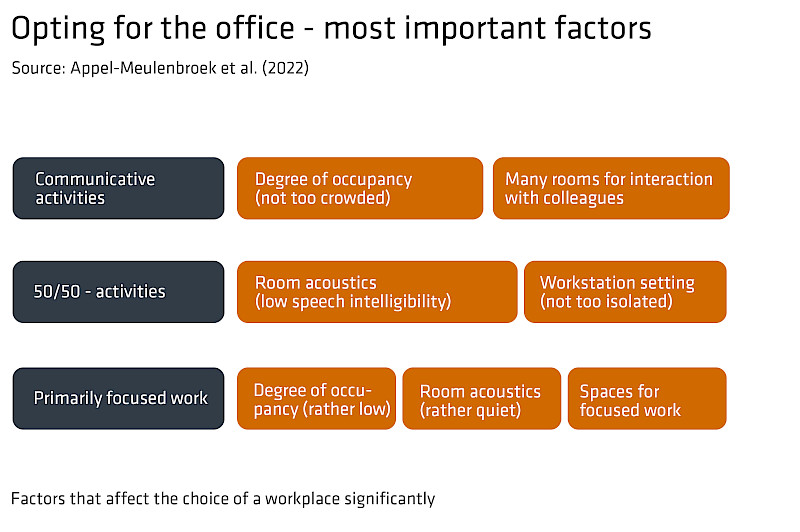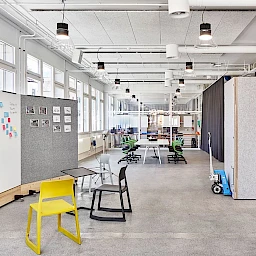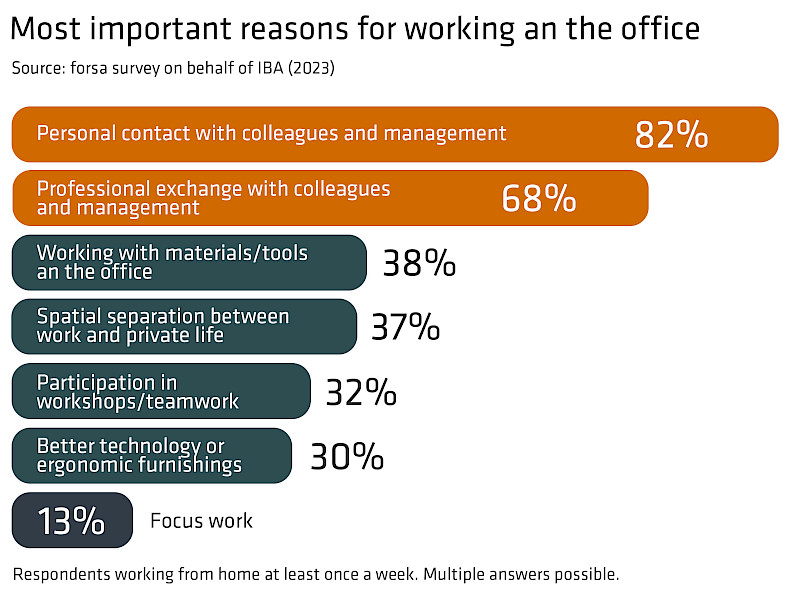Hybrid working arrangements are becoming increasingly popular. According to a recent ifo Institute survey of companies, employees in Germany spend 17% of their overall working time working from home. This percentage varies depending on the sector and the type of work. If the job can be done from home, the employees in question work from home for 1.5 days per week on average.
Hybrid work offers greater flexibility when choosing the place of work. Various factors influence the decisions regarding when employees go to work at the office and in which cases the office is the most attractive place of work. A study conducted by Appel-Meulenbroek et al. (2022) on basis of 470 employees shows that one factor in the choice of a place of work is the current day’s activities profile. The study also showed that it’s important to have retreat spaces for concentrated work in offices as well.
The activities profile as an influencing factor
An employee’s activities profile and the number of hours in a working week are key factors in the decision to work at the office. For example, part-time employees and those whose work is mainly administrative more frequently work from home. Employees with an individualized job profile and a long commute are also less often to be found at the office. If an employee’s workday mainly consists of communicative activities, there’s a 74% likelihood that he or she will prefer to work at the office rather than from home. If the workday consists of activities that require concentration as well as communication, there’s a 57% likelihood that the chosen place of work will be the office. According to the study, if employees’ jobs primarily consist of activities requiring intense concentration, the likelihood that they will work from home is 79%.
Spatial circumstances as an influencing factor
Concentration and communication are among the requirements of knowledge work. Whether employees select the office as a place of work therefore depends on the kinds of activities they engage in and also on the spatial circumstances.
The study conducted by Appel-Meulenbroek et al. (2022) distinguished between three different activity scenarios: communicative activities, 50/50 activities and focused work. In all three scenarios, the lack of available spaces for concentrated work is a clear “no go” for the employees. When employees are deciding whether they would like to work in this kind of office, generally relevant factors include the placement of their desk in relation to paths through the office, the degree of occupancy and the noise level. The respective office layout (that is, the openness of the rooms) turns out not to be relevant to the decisions for or against working at the office.
For doing focussed work, employees prefer workplaces where they can work without interruptions and they have sufficient opportunities to withdraw to a quiet area. However, this does not mean that the work area should be screened off from paths through the office. Focussed work requires room acoustics that promote concentration, an adequate selection of rooms for concentrated work and a level of occupancy that is not too high. For primarily communicative activities, the occupancy and the availability of rooms for discussion are the most important ones in relative terms for the choice of the office as the place of work. In the 50/50 scenario, the noise level and the placement of the desk in relation to paths through the office are the most important criteria for choosing an office workplace.
Another interesting result of the Appel-Meulenbroek et al. experiment is that even on days when communication is intense, employees don’t want to work in areas that are too noisy and don’t want to be disturbed by their colleagues’ conversations. They expect a sufficiently large selection of spaces where they can hold conversations, but they don’t want these spaces to be directly adjacent to their workplace.
The presence of colleagues as an influencing factor
A representative forsa survey of employees that was commissioned by the Interior Business Association (IBA) and conducted in June 2023 investigated, among other things, the most important reasons for working at the office. Personal contact with other employees, at 82%, was by far the most important reason given, followed by professional discussions at 68%. For 37% of the respondents, the separation between work and private life was a positive aspect of office work. It was closely followed by teamwork, which was cited by an average of 32% of the respondents, with employees in non-managerial positions valuing teamwork significantly higher at 39%.
The Fraunhofer Institute for Industrial Engineering (IAO) also confirms that the presence of colleagues is a significant factor in the choice of the office as a place of work. In its surveys of work arrangements and factors influencing the choice of a place of work, about a third of the respondents said that their decision regarding whether to work at the office depended on how many of their colleagues were expected to work at the office on a given day. Individual assessments differ regarding how many colleagues, and which ones, must be present in order to make the office an attractive workplace. However, according to the Fraunhofer IAO, if 40% or more of the employees on average were present on a given day, the respondents would be demonstrably happy to work at the office. But what’s the situation with regard to concentrated work? The current series of investigations by the Fraunhofer IAO aims to find out which personal factors are key criteria in the choice of a place to do focussed work. We look forward to seeing their findings.
IBA-Forum: Topic Hub “Hybrid Work”

You can find an article by Appel-Meulenbroek et al. (2022) about the findings of their study at https://www.sciencedirect.com/science/article/pii/S0272494422000299#abs0015.
The IBA study conducted in 2023 is expected to be published at the end of November 2023 at https://iba.online/publikationen/.
Cover photo: unsplash.com / @Austin Distel







